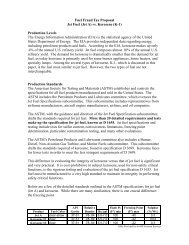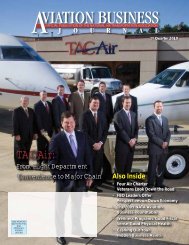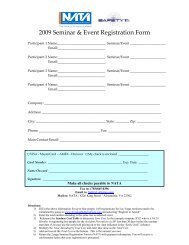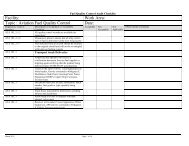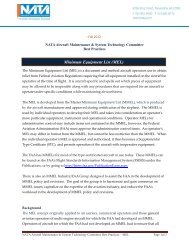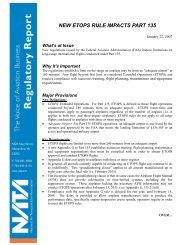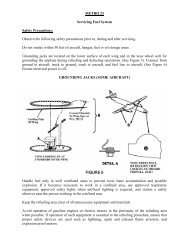On-Demand CharterContinued from page 25tion of a scheduled operation, that flight may not beconducted under Part 135 under any circumstances.Scheduled flights in turbojet-powered airplanesmust be conducted under Part 121 regulations.The restrictions outlined above are articulated inthe definition of “on-demand operation,” while thethree elements of a schedule are found within the“scheduled operation” definition. Both definitionscan be found at 14 CFR 119.3.Any empty-leg flight offered (either directly orthrough a broker) by an on-demand operator issubject to a possible FAA determination that the operatoris offering scheduled service without holdingproper authority (i.e., a Part 121 certificate), and istherefore in violation of the regulations, when theoperator offers the departure date, departure location,and arrival location and if such flight will be ina turbojet-powered airplane.How to Offer Empty-Leg <strong>Flight</strong>sSo how can an operator offer empty-leg flightswithout running afoul of the regulations? The FAAinterpretation asserts that any time the three elements(departure location, departure time and arrivallocation) are held out for a passenger-carryingoperation, it is a scheduled operation.Consequently, if an operator sets only two ofthose three elements, the FAA likely will not deemthe flight to have been a scheduled operation. Ifany one of the three elements is of the customer’schoosing, then the flight can be viewed as an ondemandoperation.During the informal discussion with <strong>NATA</strong> membersduring the Air Charter Summit, Conte wasclear that if only two elements are held out andthe third is at the customer’s discretion a scheduledoes not exist. However, he cautioned that the thirdelement must genuinely be determined by thecustomer. This position is supported by the 2006FAA legal interpretation. When pressed on the issueof “departure time” windows, Conte indicated hisbelief that the agency would not likely deem a fivedaydeparture window as establishing a departuretime element, but that a 48-hour window (or less)would likely be deemed to be establishing a departuretime.Specifically the interpretation states: “Havinga time set within which the aircraft must leavesatisfies the ‘departure time’ element,” and “theshorter the departure window..., the more it looksas though this is a scheduled operation.”As an example, an operator may list on a websitethat an aircraft is available for a charter fromSpringfield, Ill., (SPI) to Lexington, Ky., (LEX) withina specified three-day window. If a customer callsto book this flight, that customer must be allowed todepart at a time of his or her choosing. The operatorcannot during this phone conversation explainthat the aircraft is available for the listed price onlyif it departs within the next 24 hours. (See the Q&Asidebar for more examples.)Similarly, if an operator defines a departurelocation and time but establishes a broad arrivaldestination, Conte indicated that the agency wouldagain likely deem the flight to have been an ondemandoperation.No specific information on the exact meaning ofdeparture location and arrival location has beengiven, and there does not appear to be any priorinterpretations or guidance on the precise meaningof the terms, leaving the FAA with additional opportunityfor interpretation.Don’t Hide Behind Vagueness<strong>NATA</strong> cautions operators attempting to get aroundthe regulations by using vagueness in defining locations,unless the precise departure and/or arrivalairports are truly subject the customer’s desire. Forexample, offering a flight from Southern Californiato the New York area when in fact the customer willbe required to meet the aircraft at Carlsbad (CRQ)for a flight that will land at Teterboro (TEB) is notlikely to pass FAA review. However, if the offer wasgenuine in that the customer could specify anySouthern California airport (that the aircraft couldlegally use) and any airport in the greater New Yorkarea for arrival, the FAA could very easily approvethe deal, particularly if there is a large window ofopportunity for departure time.Operators should ask themselves how the customerwho booked an empty-leg flight would answerthese questions if they were posed by an FAAinspector after flight completion:• Did you choose your departure airport, departuretime, and/or arrival airport?• Did you believe you had any flexibility in determiningthese factors?Ultimately, in any potential investigation, theFAA is likely to review the totality of the circumstancesin deciding whether a schedule was heldout to the public.This information should not be construed to be legal advicewith regard to any specific advertisement or aircraft operation.It is merely intended to provide information to aidoperators in understanding the current issues surroundingthe status of empty-leg flights and how the FAA may evaluatesuch flights. Operators are encouraged to consult appropriatelegal counsel with specific questions about their empty-legflight offerings.26 Aviation Business Journal | 3 rd Quarter 2007
Q & A1. If I offer only two elements of a schedule on awebsite and then verbally communicate the thirdelement, I haven’t published a schedule, so am I stilllegally operating the flight under Part 135 on-demandrules?Example: Website offers a GV as available for a flight fromVNY to HPN, but no departure time/window is noted. Acustomer contacts the operator (directly or via a broker)and is told that the flight is indeed available for the quotedprice but only if it departs VNY within the next 24 hours.Answer: <strong>Based</strong> on information in FAA legal interpretationsand comments offered by the FAA,this type of operation could be determined to be ascheduled operation. The three elements that definea schedule are all present (departure location:VNY, arrival location: HPN, departure time: within24 hours). That only two elements were “published”and the third (time) was a verbal statement is irrelevant.Note that the regulations do not require aschedule to actually be published for one to exist.Even though an exact departure time was not specified,the passenger is limited and must leave withinthe specified 24-hour window. The FAA has indicatedthat the narrower the departure window is, themore likely it is that the operator will be deemedto be holding out a scheduled flight in situationssimilar to the example.2. What if I have an airplane based at TEB that is atVNY (the result of a one-way booking) and I offer theaircraft via a broker to any customer willing to departVNY within the next 24 hours on an eastboundflight?Answer: It is likely that you have not met the “arrivallocation” element necessary for establishing aschedule. <strong>Based</strong> on FAA information, you have likelyestablished the other elements: departure locationand departure time. To avoid the third element,the customer must truly be able take the aircraft toany eastbound location of his or her choosing, solong as the operator and aircraft can legally go tothat destination (i.e., the runway is long enough forthe airplane to land safely).3. The empty-legs are really just a posting of my futurePart 91 flights unless and until someone booksthe flight. Therefore, isn’t it true that I have not heldout a scheduled flight?Answer: You may certainly argue that the flightsposted are only a listing of future Part 91 flights.However, the concern is over what ultimately happenswith regard to a specific flight and the levelof control over any of the three elements that thecustomer was actually able to exercise. These evaluationscan be done post-flight.The most important regulatory determinationis whether a “scheduled operation” (as defined in§119.3) occurred. So, while you may argue that theempty-leg posting did not per se violate FAA regulations(particularly if the flight is never booked bya customer), the FAA could still evaluate any flightoperation after the fact to determine the conditionsof the flight and which party determined each ofthe three elements that comprise a schedule.4. I have a customer that booked a charter flight withus but will not utilize the full capacity of the airplaneand indicated a willingness to share the flight withother passengers to reduce costs. Can I advertisethis flight? Can I verbally steer customers that call tobook flights to this arrangement?Answer: The FAA has stated that even if the initialcustomer’s flight is purely an on-demand charter,the act of telling other third-parties about that flightcould constitute holding out a schedule to those additionalcustomers. That the first customer was ondemanddoes not influence an FAA finding that theadditional customers were sold a scheduled flight.The FAA’s position is that whenever the three elementsestablishing a schedule are present, a scheduleis indeed being offered. The FAA has stated itis irrelevant how the schedule is presented to thecustomer—verbally, Internet, advertisements, orany combination thereof.Jacqueline Rosser is <strong>NATA</strong>’s director of regulatoryaffairs. She can be reached at jrosser@nata.aero.Aviation Business Journal | 3 rd Quarter 200727


